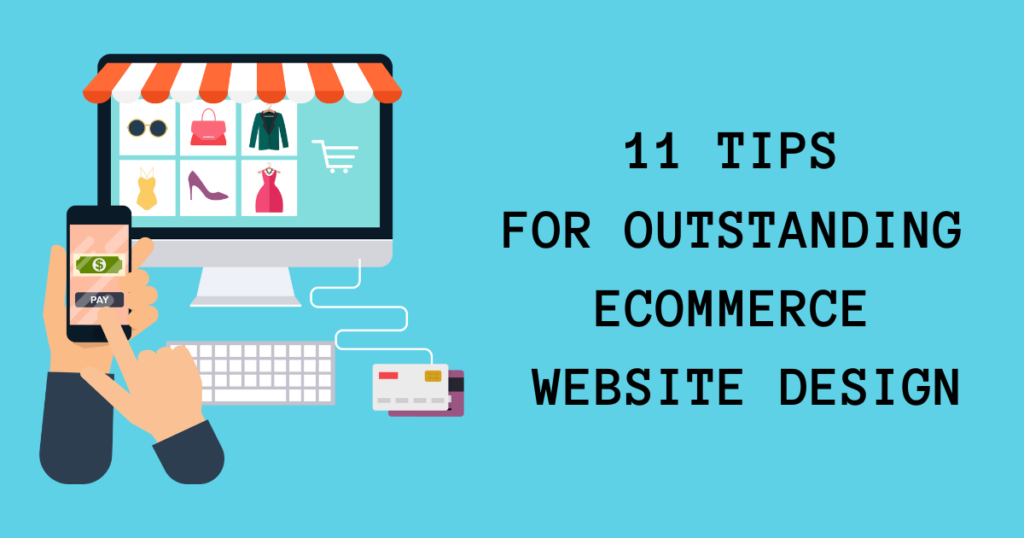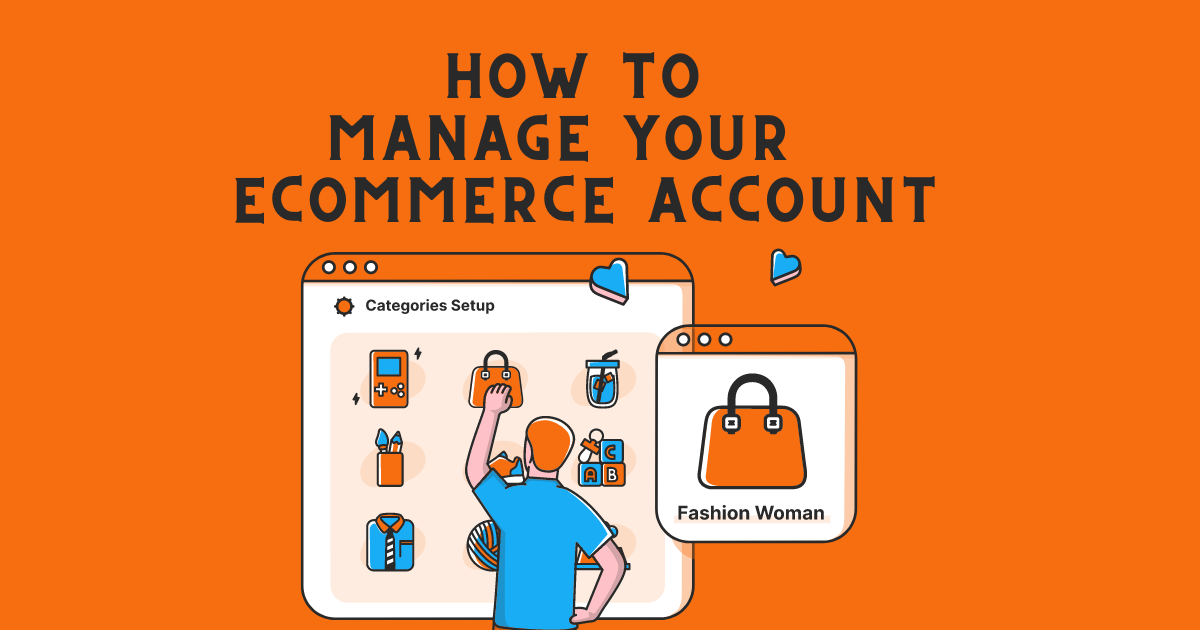When I think about shopping online, the first thing that springs to mind is how a website’s design can make or break my shopping experience. This is why I’m so passionate about sharing tips for outstanding ecommerce website design.
A well-designed ecommerce store isn’t just about looking good; it’s about creating an experience that makes customers like you and me feel comfortable, confident, and ready to buy.
Let me tell you a quick story. Last week, I was browsing for a new pair of sneakers. I stumbled upon this website – let’s just say it was love at first sight. The design was sleek, the colors popped, and everything was easy to find.
That’s when it hit me: the power of effective ecommerce website design is undeniable. It’s not just about selling products; it’s about crafting a journey that guides you seamlessly from the homepage to the checkout.
In this blog, I’ll share 11 top tips that can help transform your ecommerce website design. Whether you’re starting from scratch or looking to revamp your existing store, these insights are the golden nuggets you’ve been searching for.
Trust me, I’ve been there, and I know the difference a few changes can make. So, let’s dive into the world of ecommerce design and explore how you can make your online store not just good but outstanding.
Tip 1: User-Friendly Navigation

When it comes to ecommerce websites, navigation is like the map of a treasure hunt – it should lead users straight to the treasure, aka your products. I learned this the hard way when I first started my ecommerce business.
My site had all these cool features and designs, but customers kept getting lost. It was like sending them into a maze without an exit. That’s when I realized the golden rule: Keep it simple and straightforward.
Let’s break down what user-friendly navigation looks like for an ecommerce business. First and foremost, your menu should be easy to spot and understand. Think about it – when you enter a physical store, clear signs guide you, right? Your website should do the same.
Use simple, descriptive labels for your categories. If you sell clothing, label them as ‘Men’s Wear,’ ‘Women’s Wear,’ ‘Kids’, etc. This clarity helps users feel at ease and find what they’re looking for without any hassle.
Another key aspect is the search function. Remember the time you tried to find a specific item in a big store without asking for help? Frustrating, isn’t it? A prominent search bar on your ecommerce site is like that helpful store assistant. It should be easily accessible, ideally at the top of every page, allowing your customers to quickly find exactly what they need.
But it’s not just about finding products. Your navigation should also guide users to important information like shipping policies, return procedures, and contact details. Imagine you’re buying a gift and you need to know if it’ll arrive on time.
If that info is hard to find, you might just give up and leave. I learned to make all essential information readily available, and it significantly decreased customer frustrations and increased sales.
User-friendly navigation for ecommerce websites is about creating a clear path to what your customer needs. It’s about making their journey through your website as smooth and enjoyable as possible.
Trust me, investing time in simplifying your website’s navigation pays off by making your customers’ shopping experience effortless and pleasant. Remember, in the world of ecommerce, a pleased customer is a loyal customer.
Tip 2: Mobile Responsiveness

It’s no secret that a massive chunk of online shoppers are now browsing and buying through their mobile devices. I remember the day I checked my e-commerce website analytics and was stunned to see how many visitors were coming from smartphones and tablets.
It was a wake-up call. To cater to this growing trend, making your e-commerce website mobile-responsive isn’t just a tip. It’s a necessity.
Think about your own habits. How often do you find yourself scrolling through websites on your phone? I bet it’s quite often. The same goes for your customers. They want the convenience of shopping anywhere, at any time, right from their phones.
But if your website is hard to navigate on a small screen, takes ages to load, or looks wonky, you’re going to lose their interest fast. I learned this the hard way when a friend pointed out how difficult it was to navigate my site on her phone. That feedback was priceless.
Mobile responsiveness means your e-commerce website should automatically change to fit the screen of any device. This is not just about shrinking content to fit a smaller screen; it’s about reorganizing it for optimal viewing and interaction.
Large, easy-to-click buttons, simplified menus, and readable text sizes are essential. Remember, a thumb is your customer’s primary tool when they’re on their phone. Make it easy for them to click and scroll.
One key aspect that many forget is the checkout process. It needs to be super streamlined on mobile. I once tried to buy a gift on my phone, and I had to enter what felt like a million details on a tiny screen.
It was so frustrating that I almost gave up. Your checkout process should be as simple as possible, with features like autofill for returning customers and the option to checkout as a guest.
Lastly, regularly test your website on various mobile devices to ensure everything works smoothly. Sometimes, what looks good on a desktop doesn’t translate well on a mobile. I make it a point to check my site on different phones and tablets, just to be sure.
Enhancing your e-commerce website for mobile devices is crucial in today’s market. With the high percentage of online shoppers using their phones to browse and buy, a mobile-friendly site is important to keeping your audience engaged and willing to make a purchase. Trust me, investing in mobile responsiveness will pay off in spades in the long run.
Tip 3: Fast Loading Times

One of the most critical elements of ecommerce web design, which many overlook, is the loading time of your website. In our fast-paced world, time is of the essence, especially when it comes to creating a pleasant online shopping experience.
No one likes to wait, do they? I learned this important lesson when I noticed a high bounce rate on my website. After some digging, I found out that slow loading times were the culprit.
Let me paint a picture for you. Imagine you’re in a rush to buy a last-minute birthday gift. You find an online store that seems perfect. But, as you click on it, the pages take forever to load.
You’re likely to get frustrated and look elsewhere, right? That’s exactly how your customers feel when your site is slow. A delay of just a few seconds can make the difference between a sale and a lost opportunity.
Optimizing your website’s speed is not just about customer satisfaction; it’s also about search engine rankings. Search engines like Google rank fast-loading sites in their search results. So, a speedy site can also help you attract more traffic.
So, how do you speed things up? First, optimize your images. High-resolution images can significantly slow down your page loads. Resize and compress them without sacrificing quality. I started doing this and saw a noticeable improvement in my site’s speed.
Second, minimize the use of heavy scripts and plugins. Sure, they can add cool features to your site, but they can also slow it down. I had to let go of a few fancy widgets to keep my site speedy.
Lastly, choose a reliable web hosting service. Your hosting plays a massive role in your website’s performance. Investing in good hosting is investing in your site’s speed and, ultimately, in a pleasant online shopping experience for your customers.
Never underestimate the power of fast loading times in ecommerce web design. It’s a key factor in keeping your visitors happy and engaged. A fast website not only offers a more pleasant online shopping experience but also helps in converting visitors into customers.
Remember, in the online world, speed is not just about fast; it’s about instant.
Tip 4: High-Quality Images and Videos

If there’s one thing I’ve learned in the world of e-commerce, it’s that high-quality images and videos are the heart and soul of your product pages.
Think about it – when you’re shopping online, you can’t touch or try out the products. The only way you get to experience them is through the images and videos presented. This is your chance to make a lasting impression.
I still remember the time I was shopping online for a coffee maker. One website had such clear and detailed images. I could almost smell the coffee! That’s the power of high-quality visuals.
They close the gap between online shopping and the real-life experience. Every detail, from the texture to the color, helps create trust and confidence in your product.
For your product pages, aim to use high-resolution images that show your products from various angles. Also, consider using zoom-in features so customers can view details closely. I found that adding a video of the product in use can significantly increase the chances of a sale.
It gives a dynamic view and a better understanding of the product, which still images can’t always convey.
But remember, while quality is crucial, it’s also important to optimize these images and videos to ensure they don’t slow down your page loading times. Balancing quality with efficiency is key.
Spending on high-quality images and videos for your product pages can make a world of difference. They not only enhance the visual appeal of your e-commerce site but also provide customers with a closer look at your products, helping them make informed decisions.
After all, a picture is worth a thousand words, and in e-commerce, it might be worth a thousand sales, too!
Tip 5: Easy Checkout Process

When it comes to the checkout page of an e-commerce site, simplicity and efficiency are key. The goal is to make the process of purchasing as smooth as sailing on a calm sea.
I once lost a sale because my checkout process was too complicated. That’s when I realized the importance of a streamlined checkout.
Firstly, think about the shipping address form. This is where customers get frustrated. I remember filling out a form that was so long and complex that I almost gave up. The lesson? Keep it short and sweet. Ask only for essential information. Autofill options can be a lifesaver here, especially for returning customers.
Then, consider the layout of your checkout page. It should be clean, clear, and free of any distractions. I’ve found that having a progress bar at the top of the page helps a lot. It shows customers how many steps they have left, which reduces anxiety and confusion.
Another tip is to offer several payment options. In my experience, the more options you provide, the better your chances of closing the sale. People like having choices, whether it’s a credit card, PayPal, or other payment services.
Finally, always provide a clear confirmation message or page once the purchase is complete. There’s nothing more reassuring than a simple “Thank you, your order has been placed” message. It leaves your customers with a sense of accomplishment and trust in your service.
Optimizing your checkout page is crucial. A smooth, hassle-free checkout process not only makes it easier for customers to give you their shipping address and complete their purchase but also leaves a lasting positive impression, encouraging them to return for more shopping in the future.
Remember, in the world of e-commerce, a streamlined checkout can be the golden ticket to customer satisfaction and loyalty.
Tip 6: Effective SEO Strategies

In the world of ecommerce website design, conquering search engine optimization is like finding the secret sauce to visibility and success.
I learned this firsthand when I saw a dramatic increase in my site’s traffic after implementing some key SEO strategies.
First off, let’s talk about keywords. They are the bread and butter of SEO. You need to know what your potential customers are searching for and integrate those terms naturally into your website’s content.
When I first started, I overlooked this and missed out on a lot of traffic. Using tools to research relevant keywords and incorporating them into product descriptions, blog posts, and even image tags can make a huge difference.
Another critical aspect is site structure and navigation. Search engines favor websites that are straightforward to crawl and understand. A well-organized site with a clear hierarchy not only enhances user experience but also boosts your SEO efforts. I remember reorganizing my site’s layout, and it was a game-changer in terms of search engine rankings.
Don’t forget about mobile optimization. As search engines increasingly prioritize mobile-friendly sites, ensuring your ecommerce website is improved for mobile users is fundamental. After I optimized my site for mobile, I noticed a significant improvement in my search rankings.
Lastly, consistently update your website with fresh and relevant content. Whether it’s through blog posts, new product listings, or updates to existing pages, fresh content keeps your site dynamic and more attractive to search engines. I started adding weekly blog posts related to my products and saw a notable increase in my site’s engagement.
Effective SEO strategies are vital in ecommerce website design. They increase your visibility, drive more traffic to your site, and ultimately contribute to your business’s success.
By focusing on keywords, site structure, mobile optimization, and fresh content, you’ll be well on your way to climbing the search engine ranks. Remember, SEO might seem like a complex puzzle at first, but once you fully understand it, the results can be extremely rewarding.
Tip 7: Engaging Product Descriptions

Writing engaging product descriptions is a crucial aspect of your ecommerce shop’s success. When I first launched my online store, I underestimated the power of a well-crafted description. But soon, I realized that the right words could paint a picture and tell a story that transforms a simple product into a must-have item.
Your product descriptions should not only just list the features of your items. They should evoke emotion, create a connection, and help the customer envision the product in their life. Think about what makes your product unique and why someone should buy it.
For instance, instead of saying ‘high-quality leather bag,’ I found it more effective to describe it as a handcrafted leather bag that ages beautifully with time, perfect for the stylish, modern individual.’
Remember, your ecommerce shop isn’t just selling products; it’s selling experiences and solutions. Utilize language that connects with your target audience and reflects your brand’s voice. Adding a touch of humor or a personal story can also make descriptions more relatable and memorable.
In brief, engaging product descriptions can significantly enhance the appeal of your ecommerce shop. They play a vital role in converting browsers into buyers by providing them with compelling reasons to make a purchase. Craft each description carefully, and you’ll see how words can turn into sales.
Tip 8: Customer Reviews and Testimonials

Incorporating customer reviews and testimonials is a game-changer in e-commerce website design. When I first included customer feedback on my site, I noticed a significant increase in trust and engagement. It’s like having a vote of confidence from those who have already experienced your products.
Think about your own shopping habits. Aren’t you more likely to buy a product if you see positive reviews from other customers? That’s exactly how your visitors feel. Reviews act as social proof, encouraging prospective buyers about the quality and reliability of your products.
Make sure to prominently display these reviews and testimonials on your product pages and, if possible, on the homepage of your e-commerce site. I found that including a mix of ratings, not just the perfect scores, adds authenticity. Customers appreciate transparency and honesty.
Encouraging customers to leave reviews can be as simple as sending a follow-up email after a purchase, inviting them to share their experience. I’ve used this strategy, and it has worked wonders in generating genuine feedback.
Customer reviews and testimonials are powerful tools in e-commerce website design. They build trust, provide authenticity, and influence buying decisions. Effectively leveraging them can significantly boost the credibility and appeal of your online store.
Remember, the voice of your customers is one of the most persuasive tools you have.
Tip 9: Regular Updates and Fresh Content

Keeping your e-commerce site updated regularly with fresh content is vital for engaging and retaining customers. When I started updating my site consistently, I noticed a marked increase in repeat visitors and longer stays on the site. It’s all about giving your audience a reason to come back.
Fresh content can come in many forms – new product arrivals, updated product descriptions, blog posts related to your niche, or even seasonal promotions. For example, adding a weekly blog post on topics related to my products not only provided value to my customers but also improved my site’s SEO.
Regular updates also show that your business is active and evolving. Customers feel more confident purchasing from a site that’s lively and current. I’ve found that even simple changes like updating homepage banners or featuring customer reviews can make a big difference.
Regular updates and fresh content are key strategies to keep your e-commerce website dynamic and engaging. They not only help attract new visitors but also build a loyal customer base. Keep your site lively, and watch your audience grow!
Tip 10: Strong Branding

Strong branding is crucial for setting your ecommerce store apart in a crowded online marketplace. When I focused on developing a unique and consistent brand identity for my store, I saw a noticeable increase in customer recognition and loyalty.
Your brand should reflect in every aspect of your ecommerce store, from the logo and color scheme to the tone of your content and the style of your imagery. Consistency is key. It helps in creating a memorable and recognizable presence that resonates with your audience.
For example, choosing a color palette that aligns with your brand values and using it consistently across your website can significantly enhance brand recall.
Moreover, your brand’s voice should be clear in your product descriptions, blog posts, and customer communications. This creates a personality for your store that customers can relate to. When I started infusing my brand’s voice into every piece of content, I noticed a deeper connection with my audience.
Strong branding is essential for the success of your ecommerce store. It’s not just about a logo or a color scheme; it’s about creating an entire experience that customers recognize and trust. A well-defined brand can be the difference between just another online store and a beloved shopping destination.
Tip 11: Accessible Customer Service

For any ecommerce store, accessible customer service is as vital as the products you sell. In my journey, ensuring that my customers could easily reach out for support significantly enhanced their shopping experience and loyalty. Accessible customer service isn’t just about solving problems; it’s about building relationships.
Whether it’s through a live chat feature, a dedicated support email, or a helpline, make sure your customers can easily find and use these services. I remember a time when a customer couldn’t find the chat option on my site. That feedback led me to place it more prominently, resulting in more engaged and satisfied customers.
Additionally, consider the power of FAQ sections. By addressing common queries and concerns, you can provide instant support to your customers. When I updated my FAQ section with more detailed answers, I noticed a decrease in repetitive queries, which allowed my customer service team to focus on more complex issues.
Accessible customer service is a cornerstone of a successful ecommerce store. It’s not just about addressing issues but also about showing your customers that you value and care for their experience. A robust customer service system can significantly enhance customer satisfaction and loyalty, turning one-time buyers into repeat customers.
Ready to Implement These Tips for Outstanding Ecommerce Website Design?

As we wrap up, remember that each of these tips for outstanding ecommerce website design plays a crucial role in the success of your online store. From user-friendly navigation to accessible customer service, every element contributes to a seamless and enjoyable shopping experience for your customers.
Implementing these tips isn’t just about making your site look good; it’s about creating an environment where customers feel valued and understood. In my journey, applying these principles has not only improved my site’s performance but also deepened my connection with my audience.
Keep these tips in mind as you design or revamp your ecommerce website. They are the building blocks of a successful online presence. By focusing on these key aspects, you’re not just selling products; you’re creating a memorable brand and a loyal customer base. Here’s to the success of your ecommerce venture!





















